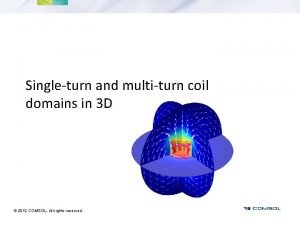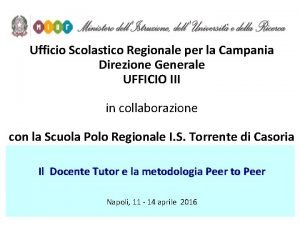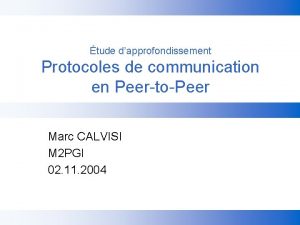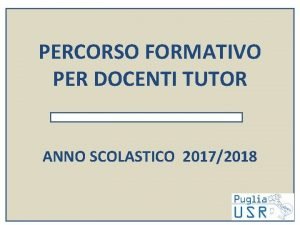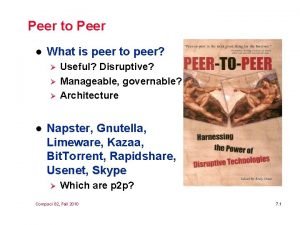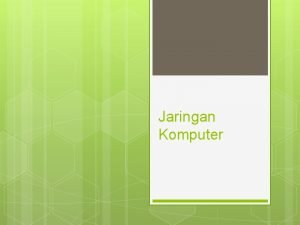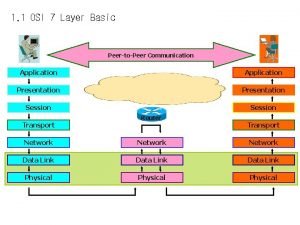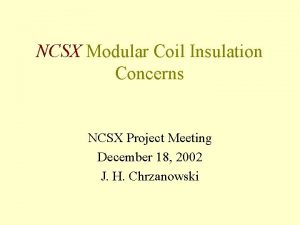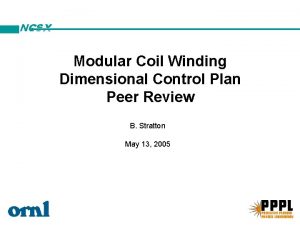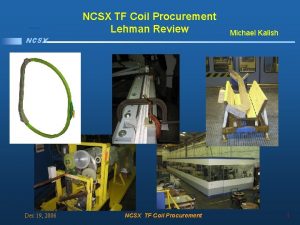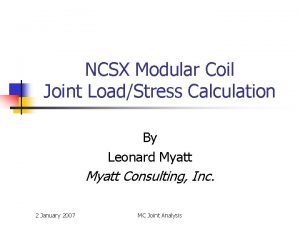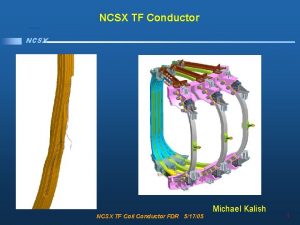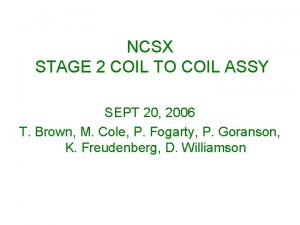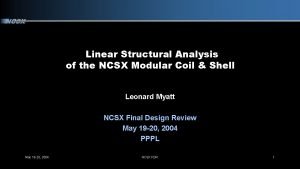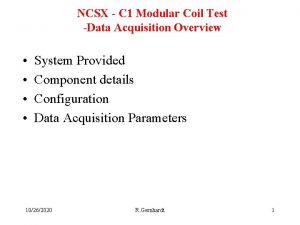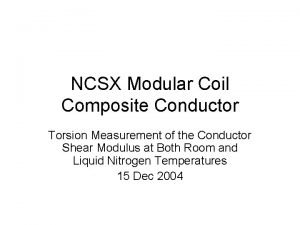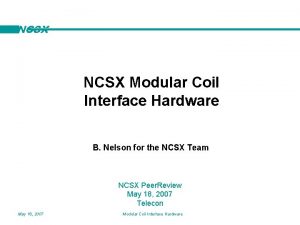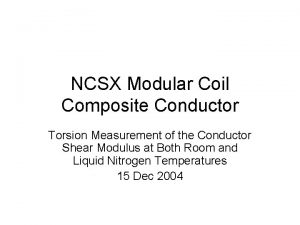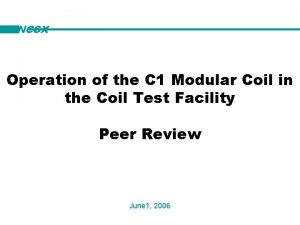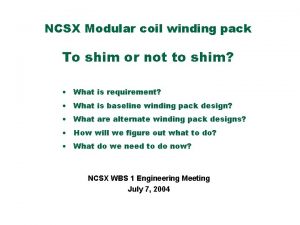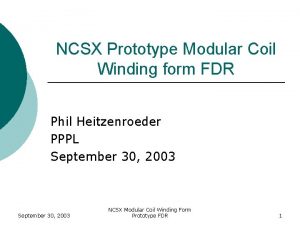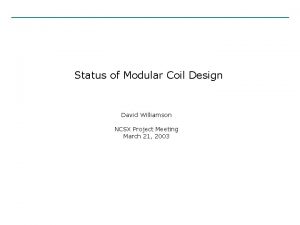NCSX Peer Review Modular Coil Electrical Joint James





![C 1 - Joint Resistance Data A-1 5 [3/20] 2 [4/7] A-2 2 [3/20] C 1 - Joint Resistance Data A-1 5 [3/20] 2 [4/7] A-2 2 [3/20]](https://slidetodoc.com/presentation_image_h/0f032abe3355787dedab21616075a94a/image-6.jpg)












- Slides: 18

NCSX Peer Review Modular Coil Electrical Joint James Chrzanowski April 24, 2006 Modular Coil Electrical Joint 1

Peer Review Charge • Has adequate testing been performed to proceed with implementation? • Have all credible risks been adequately addressed? • Have special risks to C 1 [already VPI’d] been adequately addressed? • Are the design and procedure revisions adequately documented to proceed with implementation? Modular Coil Electrical Joint 2

Typical Modular Coil Joint Torqued to 10 ft-lbs Terminal Jumper or Lug Conductor connector Belleville washers Flat washer Joint Resistance measured between these points Copper rope conductor Modular Coil Electrical Joint 3

Photo’s of C 1 Coil Joints Terminal Jumpers G-11 cr Insulators Coil Terminal Lugs Modular Coil Electrical Joint 4

History of Joint Issue • Following the VPI of C 1, the joint resistances were measured. – Readings were between 2 to 254 [3/20/06] • Note: Joint measurements were not taken prior to VPI • After some working of the joints the joint resistances were measured. – Resistances dropped to 2 to 5 [4/7/06] • Closer examination of the joints revealed other potential problems with the joint assembly Modular Coil Electrical Joint 5
![C 1 Joint Resistance Data A1 5 320 2 47 A2 2 320 C 1 - Joint Resistance Data A-1 5 [3/20] 2 [4/7] A-2 2 [3/20]](https://slidetodoc.com/presentation_image_h/0f032abe3355787dedab21616075a94a/image-6.jpg)
C 1 - Joint Resistance Data A-1 5 [3/20] 2 [4/7] A-2 2 [3/20] 2 [4/7] A-3 2 [3/20] 2 [4/7] A-6 26 [3/20] 2 [4/7] A-4 2 [3/20] 2 [4/7] A-7 23 [3/20] 2 [4/7] A-8 78 [3/20] 5 [4/7] Side B A-5 254 [3/20] 2 [4/7] B-5 3 [3/20] 2 [4/7] Side A B-6 4 [3/20] 2 [4/7] B-1 3 [3/20] 2 [4/7] B-7 4 [3/20] 2 [4/7] B-8 4 [3/20] 2 [4/7] B-4 3 [3/20] 2 [4/7] B-2 3 [3/20] 2 [4/7] B-3 3 [3/20] 2 [4/7] 3/20/06 Original data post VPI 4/7/06 Data after re-work Modular Coil Electrical Joint 6

Findings • Several of the conductor connectors protruded beyond the washer face of the jumper – This could prevent the connector from seating in the jumper or lug • The tolerance on the mating components [connectors & jumpers] could cause less then full contact – Full contact is never achieved • Finish and surface flatness of the connectors could have been better – Even if tolerances between contact faces were perfect, full surface to surface contact would not be achieved Modular Coil Electrical Joint 7

Joint Test Program • Develop solder procedure • Prove that solder joints can be made in place • Demonstrate that high resistant joint can be improved using solder • Liquid nitrogen/room temperature cyclic tests • Shock solder joint at Nitrogen temperature • How would solder process effect epoxy/ insulation leads on C 1 Modular Coil Electrical Joint 8

Solder Joint • It was determined that the joint contact surfaces could be improved if the imperfections or misalignments were filled with electrical grade silver-solder • Solder connectors using silver-tin solder – Solder used: “Stay-Brite [J. W. Harris Co. ] • 3. 4 to 3. 8% Silver/ balance Tin • Flow temperature: 430 °F/ 221 °C – Flux used: Rectorseal Nokorod E Regular paste flux • The joint will be heated using resistive heating unit Modular Coil Electrical Joint 9

Solder Procedure • Pre-silver plate and assemble joint • Install appropriate hardware and torque to 10 ft-lbs • Position heating tongs around terminal jumper • Heat parts [430 °F/ 221 °C] • Feed flux from conductor side of connector • Feed silver-solder from conductor end of connector and feed hole Modular Coil Electrical Joint 10

High Resistant Joint • Five test joints were made up with resistances varying between 2 and 8 • Several of these joints purposely had irregular surfaces and did not fit well. • It should be noted that during the preparation of these tests, some of the joints that measured 2 only had line contact where the lug and female connector met • Following the soldering operation all of the soldered joints were re-measured and had improved resistances between 0 to 1 Modular Coil Electrical Joint 11

Temperature Cycle Tests • Three of the joints were processed through six Nitrogen to room temperature cycles. Their resistances were remeasured at 20 °C. – There was no change in the resistances [0 ] • Several of the joints were then cooled again to Nitrogen temperature. Once at temperature, they were hit with a soft face hammer to determine whethere was an evidence of the solder cracking as a result of physical shock. – There was no evidence of cracking or physical change in the solder. Modular Coil Electrical Joint 12

Joint Test Data Joint no. #1 #2 #3 #4 #5 Pre-solder resistance 2 2 1 7 8 Post-solder resistance 0 0/1 0/1 Joint resistance post N 2 cycle tests - - 0 0 0 191 jumper 181 jumper 240 Lug Temperature on cable 0. 25 inch from connector °C Modular Coil Electrical Joint 13

Additional Tests- G-11 Insulator • During one of the soldering tests, a G-11 cr insulator was positioned under the jumper to determine whether the operation would effect the pre -positioned insulators. • There was no physical change in color or appearance Jumper Modular Coil Electrical Joint 14

C 1 Lead Repair • All of the modular coil joints can be soldered prior to VPI, except for C 1 that has been already completed. • A test was performed to determine whethere was any risk to the epoxy filled conductors • Results: • C 1: – No charring of the insulation – Surface temperature of the insulation did reach 240 °C – If process is used on C 1, the insulation would be protected with anti-heat paste or chill plate Modular Coil Electrical Joint 15

Findings & Recommendations • The joint resistance of a typical modular coil joint can be greatly improved to 0 to 1 [Goal] • The solder operation does not effect the insulators or brazed connections • The soldering procedure would be incorporated in the DNCSX-MCF-002 coil winding procedure as part of the present revision • Verification that the silver-solder being proposed can successfully be operated at liquid nitrogen temperatures [Dick Reed? ] Modular Coil Electrical Joint 16

Findings & Recommendations • The front taper of the conductor connectors will be modified to minimize the possible interference with the washers and joint hardware • A 3/32 inch solder feed hole would be added to each of the female jumpers and lugs, including C 1. • Drawings will have to be revised via ECN • Revisit the Belleville washers being used. Lighter weight washers would allow for more motion. Clearance around connector New feed hole Modular Coil Electrical Joint 17

Summary • The present joint design does not allow for future disassembly of all of the joints if required during maintenance periods. Solder joint will minimize these risks • This process if adopted would first be performed on C 2 which is nearing readiness for VPI, then would be incorporated into the C 1 joint assembly • The quality and integrity of the modular coil joints can be greatly improved by soldering the connectors to the jumpers and lugs after assembly Modular Coil Electrical Joint 18
 Multi turn coil
Multi turn coil Annotazioni sulla verifica effettuata peer to peer
Annotazioni sulla verifica effettuata peer to peer Peer-to-peer
Peer-to-peer Tim beamer
Tim beamer Peer to peer transactional replication
Peer to peer transactional replication Konsep dasar jaringan komputer
Konsep dasar jaringan komputer Esempi di peer to peer compilati
Esempi di peer to peer compilati Esempi di peer to peer compilati
Esempi di peer to peer compilati Relazione finale tutor tirocinio esempio
Relazione finale tutor tirocinio esempio Peer to peer l
Peer to peer l Peer to peer merupakan jenis jaringan… *
Peer to peer merupakan jenis jaringan… * Bitcoin: a peer-to-peer electronic cash system
Bitcoin: a peer-to-peer electronic cash system Features of peer to peer network and client server network
Features of peer to peer network and client server network Ambiti operativi da supportare
Ambiti operativi da supportare Peer-to-peer communication in osi model
Peer-to-peer communication in osi model Peer to peer vorteile nachteile
Peer to peer vorteile nachteile Addresss look up
Addresss look up Peer-to-peer o que é
Peer-to-peer o que é Peer to peer computing environment
Peer to peer computing environment
